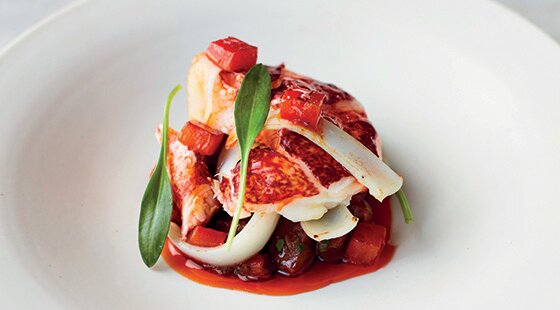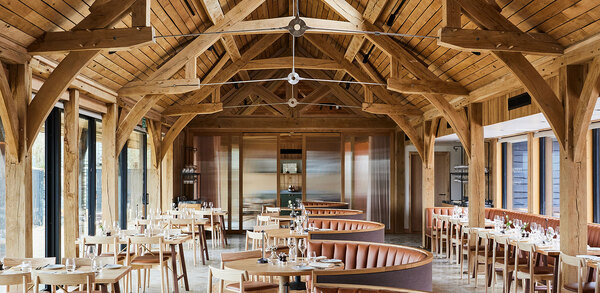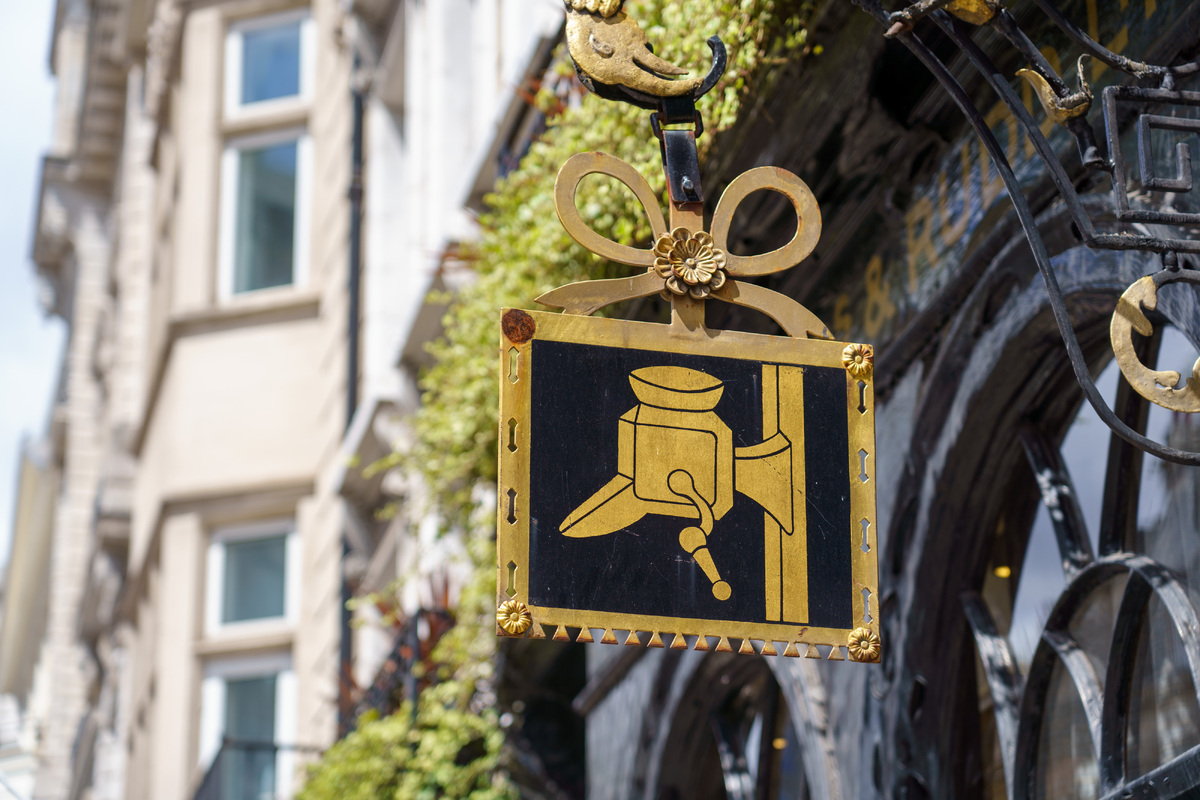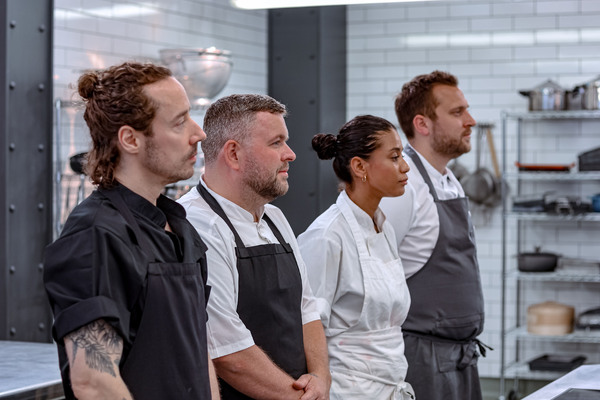Recipe of the week: lobster and cuttlefish with red pepper sauce from Restaurant Nathan Outlaw
In the late spring the fishermen in Port Isaac throw out their cuttlefish traps. Over the past few years they have been very successful at it, which is fortunate for me as I adore cuttlefish. In my opinion, it is better than its mate Mr Squid.
Here, the cuttlefish is cooked two ways: slow-braised, which in turn produces an amazing sauce, and pan-fried, which takes just 10 seconds. The idea for this dish came to me when I was out fishing and saw a lobster pot pulled up, with both lobsters and cuttlefish inside. As they were attracted to the same bait, I thought perhaps they might taste good together. Well, I can confirm that they do!
I wouldn't say this is an easy dish to cook, but it's definitely worth the effort.
Serves 6 as a starter
For the smoked paprika oil
3tsp smoked paprika
250ml light rapeseed oil
For the braised cuttlefish
1kg cuttlefish, cleaned
Light olive oil for cooking
1 white onion, peeled and finely diced
2 garlic cloves, peeled and chopped
2 flamed red peppers in brine, deseeded and chopped
1tbs thyme leaves
500ml cider
3 plum tomatoes, halved
500ml water
1tbs chopped parsley
Cornish sea salt and freshly ground black pepper
For the lobster
3 live Cornish lobsters, 600g-700g each, placed in the freezer for 30 minutes before cooking
For the red pepper dice
1 large red pepper
For the fried cuttlefish
200g cuttlefish, cleaned
Light olive oil for cooking
To garnish
Sea aster, if available, or flat-leaf parsley
First make the smoked paprika oil (a day ahead)
Sprinkle the smoked paprika into a dry frying pan and toast over a medium heat for 1-2 minutes until it releases its aroma; don't let it burn. Pour the oil into the frying pan and immediately remove from the heat. Give it a good stir and then pour into a jug. Leave to infuse and settle for 24 hours. Decant into a container and seal. The oil will keep in the fridge for up to three months.
For the braised cuttlefish
Cut the cuttlefish into 2cm slices and pat dry. Heat a large saucepan over a high heat and add a drizzle of olive oil. When it is hot, add the onion, garlic, red peppers and thyme and cook for two minutes. Pour in the cider, add the tomatoes and bring to the boil. Let it bubble over a medium heat until reduced by half. Pour in the 500ml water and bring to the boil.
Heat a frying pan over a high heat and add a drizzle of olive oil. When the oil is hot, fry the cuttlefish in batches, to avoid overcrowding the pan. Cook each cuttlefish batch for 2-3 minutes, season with salt and pepper, then transfer to a colander to drain.
Now add the cuttlefish to the cooking liquor and bring to a simmer. Cook gently for 1½-2 hours, until tender. When the cuttlefish is tender, drain off the cooking liquor into another pan and reduce it over a medium heat to a sauce-like consistency. Chop the cuttlefish into smaller pieces and add them back to the reduced sauce. Keep warm until ready to serve, or allow to cool if you are preparing ahead.
To cook the lobsters
Bring a large pan of water (big enough to hold the lobsters) to the boil and add plenty of salt (the water really needs to be as salty as the sea to ensure that the flavour of the lobster isn't lost during cooking). Lower the heat so the water is at a steady simmer.
Take your lobsters from the freezer and place them on a board. Insert the tip of a strong, sharp knife firmly into the cross on the back of each lobster's head. (This will kill it instantly, although it may still move a little.) Carefully pull the lobster tail away from the head; remove the claws too. Add the claws to the simmering water and cook for two minutes, then add the tails to the pan and cook for another three minutes. Immediately remove all the lobster from the pan and leave until cool enough to handle.
For the red pepper dice
While the lobster is cooling down, spear the red pepper on a fork and scorch over a gas flame, turning until blackened all over. (If you don't have a gas hob, blacken under a grill on its highest setting.) Put the pepper into a small bowl, cover with cling film and leave for 10 minutes to allow the steam to loosen the skin.
Scrape away the skin from the pepper with a small knife; don't rinse it or it will lose flavour. Halve the pepper and remove the core and seeds. Cut the flesh into 1cm dice. Set aside.
To prepare the lobsters for serving
Using the heel of a knife, crack the point where the claws meet the knuckles and remove the meat from the shell. Crack open the claws and extract the meat. Hold the tail firmly with both hands and crack it flat. Placing your hands either side of the lobster, pull it apart. Cut through the centre of the tail at an angle to remove the dark intestinal tract.
Trim all the tail and claw meat into neat pieces and keep to one side until ready to serve. If you're not serving the lobster straight away, refrigerate. (Save the shells for stock.)
For the fried cuttlefish
Slice the cuttlefish as thinly as possible into strips and season with salt and pepper. Place in a bowl and toss together with a generous splash of olive oil.
To prepare for serving
Preheat the grill to low. Oil the lobster pieces and season with salt and pepper. Pop under the grill to warm through. Meanwhile, gently heat up the cuttlefish stew and add the chopped parsley and two-thirds of the red pepper dice (save the rest for garnishing the dish).
Heat a large frying pan over a high heat until hot, then add a drizzle of oil. When it is hot, carefully add the raw cuttlefish strips and cook for 10 seconds, then immediately remove from the pan and drain.
To assemble and serve
Share the braised cuttlefish among six warmed plates and top with the fried cuttlefish and warm lobster. Finish with sea aster (or parsley), a few pepper dice and a drizzle of smoked paprika oil.
Taken from Restaurant Nathan Outlaw by Nathan Outlaw. Read the review here


















